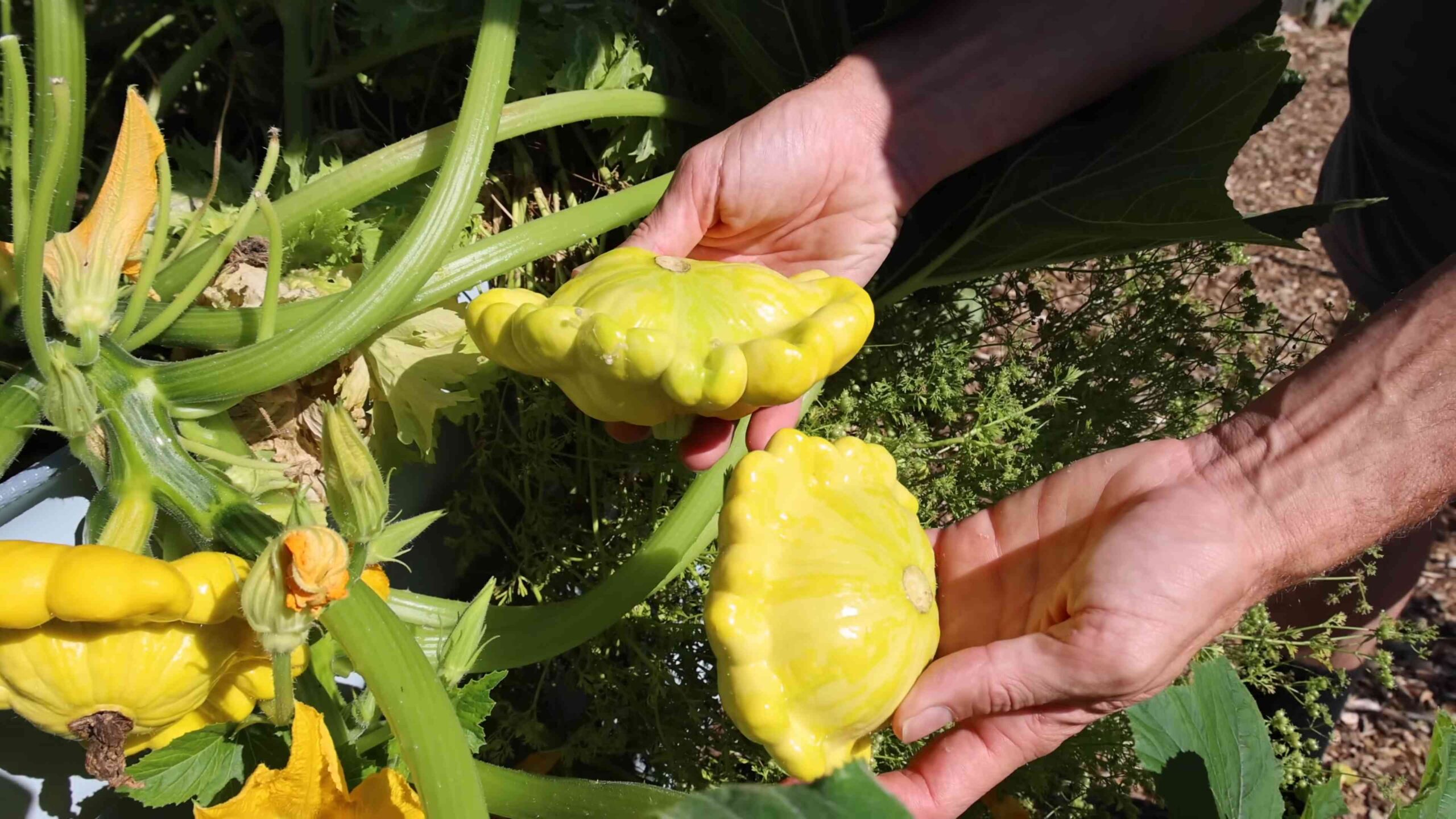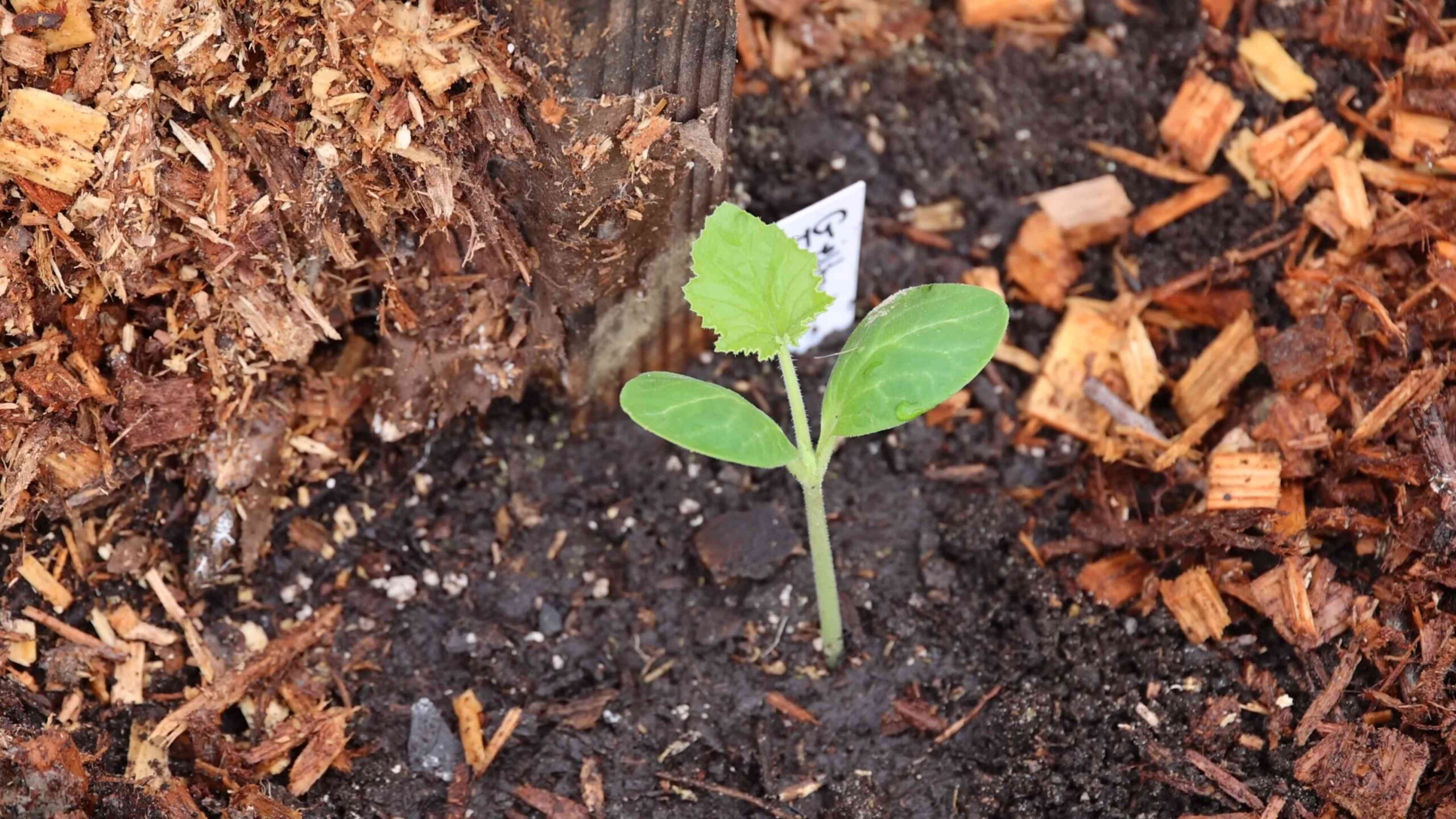Grow squash vertically and unlock a world of gardening possibilities! Are you dreaming of a bountiful squash harvest but limited by space? Or perhaps you’re tired of battling sprawling vines that take over your entire garden? I understand the struggle! For centuries, gardeners have sought innovative ways to maximize their yields, and vertical gardening, while seemingly modern, has roots stretching back to ancient civilizations using trellises for grapes and other climbing plants.
This DIY guide is your secret weapon to transform your squash game. Imagine lush, green vines climbing gracefully upwards, laden with delicious squash, all while freeing up precious ground space. Not only does it look stunning, but growing squash vertically also improves air circulation, reduces the risk of fungal diseases, and makes harvesting a breeze.
I’m going to show you simple, step-by-step instructions and clever hacks to grow squash vertically, even if you’re a complete beginner. Say goodbye to overcrowded gardens and hello to a thriving, vertical squash paradise. Let’s get started!

Growing Squash Vertically: A DIY Guide to Maximize Your Harvest
Hey there, fellow gardeners! Are you dreaming of a bountiful squash harvest but short on space? Well, I’ve got just the trick for you: growing squash vertically! It’s a fantastic way to save space, improve air circulation, and even make harvesting easier. Trust me, once you try it, you’ll be hooked. Let’s dive into how you can build your own vertical squash garden.
Why Grow Squash Vertically?
Before we get our hands dirty, let’s quickly touch on why this method is so awesome:
* Space Saving: Perfect for small gardens, balconies, or patios.
* Improved Air Circulation: Reduces the risk of fungal diseases like powdery mildew.
* Easier Harvesting: No more bending over to find hidden squash!
* Pest Control: Makes it easier to spot and manage pests.
* Aesthetic Appeal: Vertical gardens are just plain beautiful!
Choosing the Right Squash Variety
Not all squash varieties are created equal when it comes to vertical gardening. You’ll want to choose bush or semi-vining types that are more manageable. Here are a few of my favorites:
* Zucchini: Compact and productive.
* Yellow Squash: Similar to zucchini, easy to grow.
* Patty Pan Squash: Unique shape and relatively compact.
* Delicata Squash: Smaller winter squash with a delicious flavor.
* Spaghetti Squash (semi-vining): Can be trained with support.
Avoid large vining varieties like pumpkins or some butternut squashes, as they can become too heavy and difficult to support.
Building Your Vertical Support System
There are several ways to create a vertical support system for your squash. I’ll walk you through a few options, from simple to more elaborate.
Option 1: The Simple Trellis
This is the easiest and most budget-friendly option.
Materials You’ll Need:
* Wooden stakes (at least 6 feet tall)
* Heavy-duty garden twine or wire
* Optional: Chicken wire or netting
Step-by-Step Instructions:
1. Prepare the Soil: Before you start building, prepare your garden bed or container with well-draining soil rich in organic matter. Squash are heavy feeders!
2. Install the Stakes: Drive the wooden stakes into the ground around your squash plants, spacing them about 2-3 feet apart. Make sure they are securely anchored.
3. Create the Trellis: Tie the garden twine or wire horizontally between the stakes, creating a grid pattern. Space the twine about 6-12 inches apart.
4. Add Chicken Wire (Optional): For extra support, you can attach chicken wire or netting to the stakes. This provides a wider surface for the squash vines to grab onto.
5. Plant Your Squash: Plant your squash seedlings or seeds at the base of the trellis.
6. Train the Vines: As the squash vines grow, gently guide them up the trellis, weaving them through the twine or attaching them with plant clips.
Option 2: The A-Frame Trellis
This option provides a sturdier and more visually appealing support system.
Materials You’ll Need:
* Six wooden boards (2×4 inches, 6 feet long)
* Screws or nails
* Drill or hammer
* Heavy-duty garden twine or wire
* Optional: Chicken wire or netting
Step-by-Step Instructions:
1. Build the A-Frames: Create two A-frames by joining three wooden boards together at the top, forming a triangle. Secure the joints with screws or nails.
2. Connect the A-Frames: Stand the two A-frames upright and connect them at the top with another wooden board, creating a stable structure.
3. Add Horizontal Supports: Attach horizontal boards between the A-frames for added stability and to provide a surface for the squash vines to climb.
4. Create the Trellis: Tie garden twine or wire horizontally between the supports, creating a grid pattern.
5. Add Chicken Wire (Optional): Attach chicken wire or netting to the frame for extra support.
6. Prepare the Soil: Prepare the soil at the base of the A-frame trellis.
7. Plant Your Squash: Plant your squash seedlings or seeds at the base of the trellis.
8. Train the Vines: As the squash vines grow, gently guide them up the trellis.
Option 3: The Pallet Garden
Repurposing a wooden pallet is a great way to create a unique and eco-friendly vertical garden.
Materials You’ll Need:
* Wooden pallet (untreated)
* Heavy-duty landscape fabric
* Staple gun
* Potting soil
* Optional: Sandpaper
Step-by-Step Instructions:
1. Prepare the Pallet: Sand down any rough edges on the pallet to prevent splinters.
2. Line the Pallet: Cut pieces of landscape fabric to fit the back and bottom of each section of the pallet. Staple the fabric securely to create pockets for the soil.
3. Fill with Soil: Fill each pocket with high-quality potting soil.
4. Plant Your Squash: Plant your squash seedlings in the soil pockets.
5. Water Thoroughly: Water the plants thoroughly after planting.
6. Lean or Mount the Pallet: Lean the pallet against a wall or fence, or mount it securely to a sturdy structure.
7. Train the Vines: As the squash vines grow, gently guide them through the openings in the pallet.
Caring for Your Vertical Squash Garden
Once your vertical support system is in place and your squash plants are growing, it’s important to provide them with the care they need to thrive.
Watering
Squash plants need consistent moisture, especially when they are fruiting. Water deeply and regularly, especially during hot, dry weather. Aim to water at the base of the plant to avoid wetting the foliage, which can increase the risk of fungal diseases.
Fertilizing
Squash are heavy feeders and benefit from regular fertilization. Use a balanced fertilizer or compost tea every 2-3 weeks to provide them with the nutrients they need.
Pruning
Pruning can help improve air circulation and encourage fruit production. Remove any yellowing or diseased leaves. You can also prune back excessive vine growth to keep the plant manageable.
Pest and Disease Control
Keep an eye out for common squash pests like squash bugs, squash vine borers, and aphids. Use organic pest control methods like insecticidal soap or neem oil to manage infestations. To prevent fungal diseases, ensure good air circulation and avoid overhead watering.
Supporting the Fruit
As your squash fruits develop, they may become heavy and require additional support. You can use slings made from pantyhose or netting to support the fruit and prevent them from breaking off the vine.
Pollination
Squash plants have separate male and female flowers. Bees and other pollinators are essential for transferring pollen from the male flowers to the female flowers, which results in fruit production. If you notice a lack of pollinators in your garden, you may need to hand-pollinate the flowers.
How to Hand-Pollinate Squash:
1. Identify Male and Female Flowers: Male flowers have a long, thin stem, while female flowers have a small, immature fruit at the base.
2. Collect Pollen: In the morning, when the flowers are open, gently remove a male flower.
3. Transfer Pollen: Remove the petals from the male flower and gently rub the pollen-covered stamen onto the stigma of the female flower.
4. Repeat: Repeat this process for several female flowers.
Harvesting Your Squash
The time it takes for squash to mature depends on the variety. Summer squash like zucchini and yellow squash are typically ready to harvest in 50-60 days, while winter squash like delicata and spaghetti squash take longer, around 90-100 days.
How to Harvest Squash:
* Summer Squash: Harvest summer squash when they are young and tender, about 6-8 inches long. Use a sharp knife to cut the squash from the vine.
* Winter Squash: Harvest winter squash when the skin is hard and the stem is dry. Leave about 2 inches of stem attached to the squash.
Troubleshooting
Even with the best care, you may encounter some challenges when growing squash vertically. Here are a few common problems and how to address them:
* Squash Vine Borers: These pests can tunnel into the stems of squash plants, causing them to wilt and die. To prevent squash vine borers, wrap the base of the stems with aluminum foil or netting. If you see signs of infestation, you can try injecting Bacillus thuringiensis (Bt) into

Conclusion
So, there you have it! Growing squash vertically isn’t just a gardening trend; it’s a game-changer for anyone looking to maximize their garden space, improve their harvest, and add a touch of visual appeal to their outdoor oasis. We’ve explored the numerous benefits, from increased air circulation that combats common squash diseases like powdery mildew, to easier harvesting and pest control. It’s a win-win-win!
But the real magic lies in the experience. Imagine strolling through your garden, admiring the vibrant green vines laden with plump, healthy squash, all neatly arranged and easily accessible. No more bending over, no more navigating sprawling vines that take over your entire garden. Just pure gardening joy.
Don’t be afraid to experiment with different varieties of squash. While smaller varieties like zucchini, yellow squash, and delicata are naturally well-suited for vertical growing, you can also successfully train larger varieties like butternut squash and even some smaller pumpkins with proper support and pruning. Consider using different types of trellises, from simple A-frames to elaborate arches, to create a visually stunning and productive garden feature. You can even repurpose old ladders or fences for a rustic, eco-friendly touch.
And speaking of support, remember that the key to successful vertical squash growing is providing adequate support for the heavy fruits. Use strong netting, sturdy twine, or even old pantyhose to cradle the squash as they develop, preventing them from breaking off the vine. Regular monitoring and adjustments are essential, especially as the squash grows larger.
Beyond the practical benefits, growing squash vertically offers a unique opportunity to connect with nature and appreciate the beauty of the growing process. It’s a chance to learn new skills, experiment with different techniques, and create a garden that is both productive and aesthetically pleasing.
We encourage you to embrace this innovative approach to gardening and discover the many rewards of vertical squash cultivation. Whether you’re a seasoned gardener or a complete beginner, this DIY trick is surprisingly easy to implement and offers a significant return on investment.
So, grab your seeds, build your trellis, and get ready to experience the joy of growing squash vertically. And most importantly, don’t forget to share your experiences with us! We’d love to see your vertical squash gardens and hear about your successes (and challenges!). Share your photos, tips, and tricks in the comments below, and let’s inspire each other to create thriving, vertical gardens. Let’s all learn how to **grow squash vertically** together!
Frequently Asked Questions (FAQ)
What types of squash are best suited for vertical growing?
Smaller, bush-type squash varieties like zucchini, yellow squash, and delicata are ideal for vertical growing due to their manageable size and weight. However, with proper support and pruning, you can also successfully grow larger vining varieties like butternut squash, acorn squash, and even some smaller pumpkins vertically. The key is to provide adequate support for the developing fruits and to prune the vines to encourage fruit production rather than excessive vegetative growth. Consider the mature size and weight of the squash when choosing a variety for vertical growing.
What kind of trellis or support system should I use?
The type of trellis or support system you use will depend on the variety of squash you’re growing and the space you have available. For smaller squash varieties, a simple A-frame trellis, a sturdy tomato cage, or even a section of chicken wire attached to posts can work well. For larger vining varieties, you’ll need a more robust structure, such as a heavy-duty trellis made of wood or metal, or a strong netting system attached to a frame. Ensure the trellis is tall enough to accommodate the mature height of the squash vines and strong enough to support the weight of the developing fruits. Regularly inspect the support system and make adjustments as needed to prevent the squash from breaking off the vine.
How do I train the squash vines to grow vertically?
As the squash vines grow, gently guide them up the trellis or support system, using twine or plant ties to secure them in place. Regularly check the vines and adjust the ties as needed to ensure they are not constricting the stems. Prune away any side shoots or excessive foliage to encourage the plant to focus its energy on fruit production. Be patient and persistent, as it may take some time for the vines to fully adapt to growing vertically.
How do I support the heavy squash fruits as they develop?
As the squash fruits grow larger, they may require additional support to prevent them from breaking off the vine. You can use slings made of netting, old pantyhose, or fabric scraps to cradle the squash and distribute their weight. Tie the slings to the trellis or support system, ensuring they are securely attached. Regularly monitor the squash and adjust the slings as needed to accommodate their increasing size and weight.
How often should I water and fertilize vertically grown squash?
Vertically grown squash may require more frequent watering and fertilization than squash grown on the ground, as the soil in containers or raised beds tends to dry out more quickly. Water deeply and regularly, especially during hot, dry weather. Fertilize every two to three weeks with a balanced fertilizer or a fertilizer specifically formulated for vegetables. Monitor the plants for signs of nutrient deficiencies, such as yellowing leaves, and adjust the fertilization schedule accordingly.
Are there any special considerations for growing squash vertically in containers?
When growing squash vertically in containers, choose a large container with good drainage to accommodate the plant’s root system. Use a high-quality potting mix that is well-draining and rich in organic matter. Provide adequate support for the vines and fruits, as described above. Water and fertilize regularly, as containers tend to dry out more quickly than garden beds. Consider using a self-watering container or adding a layer of mulch to help retain moisture.
How do I prevent pests and diseases when growing squash vertically?
Growing squash vertically can help improve air circulation and reduce the risk of fungal diseases like powdery mildew. However, it’s still important to monitor the plants regularly for pests and diseases. Inspect the leaves and stems for signs of aphids, squash bugs, squash vine borers, and other common squash pests. Use organic pest control methods, such as insecticidal soap or neem oil, to control infestations. If you notice signs of fungal diseases, such as powdery mildew, treat the plants with a fungicide or baking soda solution. Remove any infected leaves or stems to prevent the disease from spreading.
Can I grow squash vertically indoors?
While it’s possible to grow squash vertically indoors, it requires a significant amount of light and space. You’ll need to provide the plants with at least six to eight hours of direct sunlight per day, or supplement with grow lights. Choose a compact squash variety that is well-suited for container growing. Provide adequate support for the vines and fruits, and water and fertilize regularly. Be aware that indoor squash plants may be more susceptible to pests and diseases, so monitor them closely and take appropriate action if necessary.
What if my squash isn’t producing fruit?
There are several reasons why your squash plant might not be producing fruit. One common cause is lack of pollination. Squash plants have separate male and female flowers, and the female flowers need to be pollinated in order to produce fruit. If you’re not seeing many bees or other pollinators in your garden, you may need to hand-pollinate the flowers yourself. Another possible cause is nutrient deficiency. Make sure you’re fertilizing your squash plants regularly with a balanced fertilizer. Overcrowding can also inhibit fruit production, so make sure your plants have enough space to grow. Finally, extreme temperatures can also affect fruit set. If it’s too hot or too cold, the flowers may not be able to pollinate properly.
How do I know when my squash is ripe?
The best way to determine when your squash is ripe is to check the seed packet or plant tag for the specific variety you’re growing. Generally, summer squash like zucchini and yellow squash are harvested when they are young and tender, while winter squash like butternut squash and acorn squash are harvested when they are fully mature and have a hard rind. The skin of the squash should be firm and dull, and the stem should be dry and brown. You can also tap the squash; a ripe squash will sound hollow.





Leave a Comment